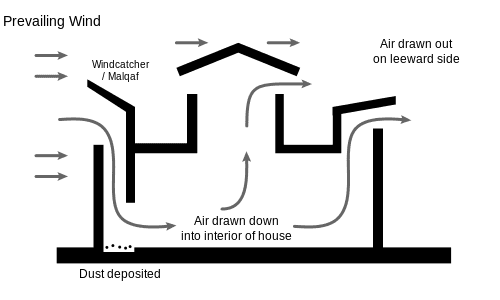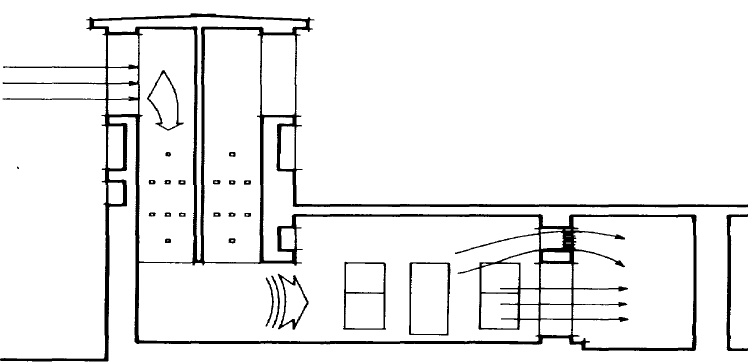The solutions offered from ancient Mediterranean architecture give us some hints on how to solve air cooling issues whilst avoiding energy-consuming plants to provide comfort in modern buildings.
Artificial air conditioning is becoming more and more mainstream in modern architecture: however, it can have negative effects on health and there is cost associated with high electricity consumption. Environmental sustainability researches suggest to explore the pearls of wisdom of our ancestors, who already found simple, economic and safe solutions to overcome the problem.
The Middle East climate is hot and dry, with daily outside temperatures during summer from 40°C to 55°C: in this condition particular strategies were adopted in the past by local populations to improve living conditions.
First of all, the layout of the houses is the first choice that allows to take advantage of the presence of the sun and the wind, for the buildings to protect one another from the sun and allow higher ventilation.
Secondly, the most advanced natural cooling technologies were developed from Arabic and Persian culture: malqaf, qa’a and bad-ghir are three examples of ancient building taking advantage of natural ventilation.

The Malqaf is a tower used to catch the air situated in a high position on top of the buildings, with a crown of column around facing the dominant winds. During the night the tower walls absorb heat from the air contained in the tower and the denser cooled air goes down inside the building; during the day, the walls serve to keep the temperature lower (in presence of wind, this process is accelerated). The Malqaf are huge buildings: Iranian ones can be five-eight meters high; Egyptian ones are characterized by a wooden cover inclined by 30-45°; in Pakistan there are thousands of wind catchers, all aligned and oriented towards the same direction, because in that region the wind always blows from the same direction. More sophisticated towers were built with pads that people could orient from the building, depending on the wind.
Another interesting building is the Qa’a, descending from Turkish tradition and taking advantage of the principle of the extraction of the air. The wind escape is a breach situated leeward, that allows the hottest air of the internal to escape, thanks to the decompression created in the opening, which in turn moves the air flows. The principle underlying the Qu’a is simple: during summer the hot air from the environment tend to rise high and exits from the openings and allows cooler air to enter; during winter the openings are closed with glass and the greenhouse effect heats up the building.

The Bad-ghir (literally “wind catcher”) is another system used in the Gulf. The process underlying is thermic ventilation (convection): the structure is a tower with light walls (usually square-based) and divided in height or more sectors, squared or triangular. Irrespective of the location where the tower is situated, the season or the time of the day, at least two consecutive sectors will be in the shade and this will determine, inside the tower, a double parallel airflow of exhaust hot air and incoming cool one. The Bad-ghir also takes advantage of the same principle behind the Malqaf, of hot air going up and cold air going down. If the tower, the height and the orientation are well-designed, we could grant from 6°C to 10°C of cooling.
The most effective natural coolers in traditional Arabic culture are fountains: these populations were already aware of the power of evaporation to cool the air. Evaporative cooling is a process where the effect of evaporation of water molecules of the air is used as a natural thermic reservoir: the sensible heat of the air is given to the water molecules in the form of latent heat, to allow evaporation. A fountain built in the mid-lower part of a wind catcher can increase the effect of the air cooling through evaporation. Most of the times a marble carved plate called salsabil is built inside the fountain: the irregular surface guarantees a higher movement of the water molecules. Another way of controlling the microclimate was the mashrabìya, a carved wooden screen, applied on the facades’ openings, whose function was to lower the air temperature and increase the humidity, thanks to the material used.
A famous example is the building Muhib Al Din Ashafei in Cairo in Egypt (1350 a.C.): the malqaf, situated up-wind, catches the air of the dominant winds, let it flow down the building, where there is a fountain which increases the relative humidity and lowers the temperature of the air. The airflow exits thanks to stack effect, through the wooden grills situated in the clerestory which is in direct contact with the sunbeams and, therefore, increases the desired effect. The natural heating of the clerestory does not influence the microclimate, because it is situated on the top of the roof and very far from the liveable space.
Another interesting case of use of evaporation to cool the temperature is the Ziza Palace in Palermo (IT), built in 1166 during the Norman domination (after centuries were Sicily was dominated by Muslim Empire) from King Guglielmo II. The massive walls serve as a barrier to protect the internal part of the palace from the solar heating. A long corridor was built on the west side of the palace, where the openings to the outside in this area are reduced to the minimum, to avoid the sun to heat the palace in the summertime. But the most impressive expedient used in this palace is the huge fountain in front of the building, which did not only serve as a decorative tool: the air skimming the water granted a fresh breeze flowing until the façade, which was marked with clerestories to allow it to flow inside, reaching the fountain room. The presence of water increased the relative humidity of the air, before it even started flowing to the upper parts of the building. The cool airflows entering the building were taking the place of the hottest ones, exhausting from the high ventilation towers. Moreover, the central hall of the second floor of the building and its adjacent spaces were opened on the roof, granting the circulation of the air due to stack effect; the little clerestories on the east and west sides ensured horizontal ventilation, to add to below mentioned stack effect.